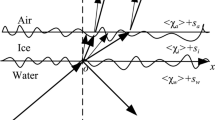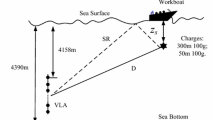Abstract
It is better to use a simple configuration to enhance the applicability of ocean environment inversion in shallow water. A matched-field inversion method based on a horizontal line array (HLA) is used to retrieve the variation of sound speed profile. The performance of the inversion method is verified in the South China Sea in June, 2010. An HLA laid at bottom was used to receive signals from a bottom-mounted transducer. Inverted mean sound speed profiles from 9-hour long acoustic signals are in good agreement with measurements from two temperature chains at the sites of the source and receiver. The results show that an HLA can be used to monitor the variability of shallow-water sound speed profile.
Similar content being viewed by others
References
Munk W H, Wunsch C. Ocean acoustic tomography: A scheme for large scale monitoring. Deep Sea Res, 1979, 26(A): 123–161
Munk W H, Spindel R C, Baggeroer A B, et al. The heard island feasibility test. J Acoust Soc Am, 1994, 96: 2330–2342
Worcester P F, Spindel R C. North pacific acoustic laboratory. J Acoust Soc Am, 2005, 117: 1499–1510
Worcester P F, Munk W H, Spindel R C. Acoustic remote sensing of ocean gyres. Acoust Tod, 2005, 1(1): 11–17
Munk W H, Wunsch C. Ocean acoustic tomography: Rays and modes. Rev Geophys Space Phys, 1983, 21: 777–793
Shang E C. Ocean acoustic tomography based on adiabatic mode theory. J Acoust Soc Am, 1989, 85: 1531–1537
Baggeroer A B, Kuperman W A, Mikhalevsky P N. An overview of matched field methods in ocean acoustics. IEEE J Ocean Eng, 1993, 18: 401–424
Tolstoy A, Diachok O, Frazer N L. Acoustic tomography via matched field processing. J Acoust Soc Am, 1991, 89(3): 1119–1127
Gerstoft P, Gingras D. Parameter estimation using multi-frequency range dependent acoustic data in shallow water. J Acoust Soc Am, 1996, 99(5): 2839–2850
Snellen M, Simons D G, Siderius M, et al. An evaluation of the accuracy of shallow water matched field inversion results. J Acoust Soc Am, 2001, 109: 514–527
Tolstoy A, Diachok O, Frazer L N. Acoustic tomography via matched field processing. J Acoust Soc Am, 1991, 89(3): 1119–1127
Siderius M, Hermand J P. Yellow shark spring 1995: Inversion results from sparse broadband acoustic measurements over a highly range-dependent soft clay layer. J Acoust Soc Am, 1999, 106(2): 637–651
Felisberto P, Jesus S M, Stephan Y, et al. Shallow water tomography with a sparse array during the intimate’98 sea trial. In: MTS/ IEEE, editor, Proceedings MTS/IEEE Oceans’2003, San Diego, USA, 2003. 571–575
Soares C, Jesus S M, Coelho E. Acoustic oceanographic buoy testing during the maritime rapid environmental assessment 2003 sea trial. Simons D, ed. In: Proc. of European Conference on Underwater Acoustics 2004, Delft, Netherlands, 2004. 271–279
Soares C, Jesus S M. Matched-field tomography using an acoustic oceanographic buoy. In: Jesus S M, ed, Proceedings of European Conference on Underwater Acoustics 2006, Carvoeiro, Portugal, 2006. 717–722
Yu Y X, Li Z L, He L. Matched-field inversion of sound speed profile in shallow water using a parallel genetic algorithm. Chin J Oceanol Limnol, 2010, 28(5): 1080–1085
He L, Li Z L, Zhang R H, el al. Inversion for sound speed profiles in the northern of South China Sea (in Chinese). Sci Sin-Phys Mech Astron, 2011, 41(1): 49–57
Li F H, Zhang R H. Inversion for sound speed profile by using a bottom mounted horizontal line array in shallow water. Chin Phys Lett, 2010, 27(8): 084303-1–4
Li Z L, Zhang R H, Badiey M, et al. Arrival time fluctuation of normal modes caused by solitary internal waves (in Chinese). Sci Sin-Phys Mech Astron, 2013, 43(1): s62–s67
Westwood E K. Broadband matched-field source localization. J Acoust Soc Am, 1992, 91: 2777–2798
Jensen F B, Kuperman W A, Porter M B, et al. Computational Ocean Acoustics. 2nd ed. New York: Springer, 2011
Author information
Authors and Affiliations
Corresponding author
Rights and permissions
About this article
Cite this article
Li, Z., He, L., Zhang, R. et al. Sound speed profile inversion using a horizontal line array in shallow water. Sci. China Phys. Mech. Astron. 58, 1–7 (2015). https://doi.org/10.1007/s11433-014-5526-x
Received:
Accepted:
Published:
Issue Date:
DOI: https://doi.org/10.1007/s11433-014-5526-x




